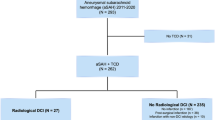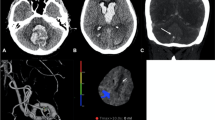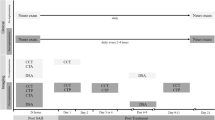Abstract
Background
Delayed cerebral ischemia (DCI) is an independent predictor of an unfavorable outcome after aneurysmal subarachnoid hemorrhage (aSAH). Many centers, but not all, use transcranial Doppler (TCD) to screen for vasospasm to help predict DCI. We used the United Kingdom and Ireland Subarachnoid Haemorrhage (UKISAH) Registry to see if outcomes were better in centers that used TCD to identify vasospasm compared to those that did not.
Methods
TCD screening practices were ascertained by national survey in 13 participating centers of the UKISAH. The routine use of TCD was reported by 5 “screening” centers, leaving 7 “non-screening” centers. Using a cross-sectional cohort study design, prospectively collected data from the UKISAH Registry was used to compare DCI diagnosis and favorable outcome (Glasgow Outcome Score 4 or 5) at discharge based on reported screening practice.
Results
A cohort of 2028 aSAH patients treated ≤ 3 days of hemorrhage was analyzed. DCI was diagnosed in 239/1065 (22.4%) and 220/963 (22.8%) of patients in non-screening and screening centers respectively while 847/1065 (79.5%) and 648/963 (67.2%) achieved a favorable outcome. Odds ratios adjusted for age, injury severity, comorbidities, need for cerebrospinal fluid diversion, and re-bleed returned neutral odds of diagnosing DCI of 0.90 (95% CI 0.72–1.12; p value = 0.347) in screening units compared to those of non-screening units but significantly decreased odds of achieving a favorable outcome 0.56 (95% CI 0.42–0.82; p value < 0.001).
Conclusions
Centers that screened for vasospasm using TCD had poorer in-hospital outcomes and similar rates of DCI diagnosis compared to centers that did not.



Similar content being viewed by others
References
Connolly E, Rabinstein A, Carhuapoma J et al (2012) Guidelines for the management of aneurysmal subarachnoid haemorrhage: a guideline for healthcare professionals from the American Heart Association/American Stroke Association. Stroke 43(6):1711–1737
Dorsch N (2011) A clinical review of cerebral vasospasm and delayed ischaemia following aneurysm rupture. Acta Neurochir Suppl 110:5–6
Erlich G, Kirshning T, Wenz T et al (2016) Is there an influence of routine daily transcranial Doppler examination on clinical outcome in patients after aneurysmal subarachnoid hemorrhage? World Neurosurg 88:214–221
Francoeur C, Mayer S (2016) Management of delayed cerebral ischemia after subarachnoid hemorrhage. Crit Care 20:277
Gathier C, van den Bergh W, van der Jagt M et al (2018) Induced hypertension for delayed cerebral ischaemia after aneurysmal subarachnoid haemorrhage: a randomised clinical trial. Stroke 49(1):76–83
Hollingworth M, Chen P, Goddard A et al (2015) Results of an international survey on the investigation and endovascular management of cerebral vasospasm and delayed cerebral ischemia. World Neurosurg 83:1120–1126
Kissoon N, Mandrekar J, Fugate J et al (2015) Positive fluid balance is associated with poor outcomes in subarachnoid hemorrhage. J Stroke Cerebrovasc Dis 24:2245–2251
Kumar G, Albright K, Donnelly J et al (2017) Trends in transcranial Doppler monitoring in aneurysmal subarachnoid hemorrhage: a 10-year analysis of the nationwide inpatient sample. J Stroke Cerebrovasc Dis 26:851–885
Kumar G, Shahripour R, Harrigan M (2016) Vasospasm on transcranial Doppler is predictive of delayed cerebral ischemia in aneurysmal subarachnoid hemorrhage: a systematic review and meta-analysis. J Neurosurg 124(5):1257–1264
Linn F, Rinkel G, Algra A, Van Gijn J. (1996) Incidence of subarachnoid hemorrhage role of region, year, and rate of computed tomography: a meta-analysis. Stroke; 27:625–629
Lennihan L, Mayer S, Fink M et al (2000) Effect of hypervolemic therapy on cerebral blood flow after subarachnoid hemorrhage a randomized controlled trial. Stroke 31:383–391
Lovelock C, Rinkel G, Rothwell P (2010) Time trends in outcome of subarachnoid hemorrhage population-based study and systematic review. Neurology 74:1494–5101
Macdonald R, Schweizer T (2017) Spontaneous subarachnoid haemorrhage. Lancet 389:655–666
Mackey J, Khoury J, Alwell K et al (2016) Stable but declining case-fatality rates of subarachnoid haemorrhage in a population. Neurology 22(87):2192–2197
Muench E, Horn P, Bauhuf C et al (2007) Effects of hypervolemia and hypertension on regional cerebral blood flow, intracranial pressure, and brain tissue oxygenation after subarachnoid hemorrhage. Crit Care Med 35(8):1844–1851
Raabe A, Beck J, Keller M et al (2005) Relative importance of hypertension compared with hypervolemia for increasing cerebral oxygenation in patients with cerebral vasospasm after subarachnoid hemorrhage. J Neurosurg 103(6):974–981
Raper D, Allan R (2010) International subarachnoid trial in the long run: critical evaluation of the long-term follow-up data from the ISAT trial of clipping vs coiling for ruptured intracranial aneurysms. Neurosurgery 66:1166–1169
Rinkel G, Algra A (2011) Long-term outcomes of patients with aneurysmal subarachnoid haemorrhage. Lancet Neurol 10:349–356
Rooji N, Rinkel G, Dankbaar J et al (2013) Delayed cerebral ischaemia after subarachnoid haemorrhage: a systematic review of clinical laboratory and radiological predictors. Stroke 44(1):43–54
Roos R, de Haan R, Beenen L et al (2000) Complications and outcome in patients with aneurysmal subarachnoid haemorrhage: a prospective hospital based study in the Netherlands. J Neurol Neurosurg Psychiatry 68:337–341
Rosengart A, Axhultheiss K, Tolentino J et al (2007) Prognostic factors for outcome in patients with aneurysmal subarachnoid haemorrhage. Stroke 38(8):2315–2321
Scott R, Eccles F, Molyneux A et al (2010) Improved cognitive outcomes with endovascular coiling of ruptured intracranial aneurysms neuropsychological outcomes from the International Subarachnoid Aneurysm Trial (ISAT). Stroke 41:1743–1747
Stegmayr B, Eriksson M, Asplund K (2004) Declining mortality from subarachnoid hemorrhage changes in incidence and case fatality from 1985 through 2000. Stroke 35:2059–2063
Teasdale G, Drake C, Hunt W et al (1988) A universal subarachnoid hemorrhage scale: report of a committee of the World Federation of Neurosurgical Societies. J Neurol Neurosurg Psychiatry 51:1457
Vergouen M, Vermeulen v GJ et al (2010) Definition of delayed cerebral ischemia after aneurysmal subarachnoid hemorrhage as an outcome event in clinical trials and observational studies. Stroke 41(10):2391–2395
Wilson D, Nakaji P, Albuquerge F et al (2013) Time course of recovery following poor grade SAH: incidence of delayed improvement and implications for SAH outcome study design. J Neurosurg 119:606–612
Acknowledgements
We thank Professor Mark Hamer for his statistical advice and Dr Alice Harper for her editorial assistance.
Author information
Authors and Affiliations
Corresponding author
Ethics declarations
Conflict of interest
The authors declare that they have no conflict of interest.
Ethical approval
For this type of study, no formal consent was required.
Additional information
Publisher’s note
Springer Nature remains neutral with regard to jurisdictional claims in published maps and institutional affiliations.
Comments
This study addresses an array of pitfalls in the treatment of aSAH patients. Firstly, the definition of vasospasm: which diagnostic tool and criteria can unequivocally establish its presence? Once established: how is it related to clinical symptoms and which impact will it have on outcome? Is the presence of vasospasm interchangeable with the presence of delayed cerebral ischemia (DCI)? Which criteria warrant therapeutical responses? There is no clear consensus on these questions other than both vasospasm and DCI are multifactorial and interwoven and both are subject to interpretation.
In the present study, all centres applied induced hypertension when DCI was diagnosed. Induced hypertension is widely used but concerns have been risen regarding its effectiveness and potential risks. It remains to be established what is the correct initiation time, length and level for induced hypertension. Furthermore, mere blood pressure levels are often used as therapeutic guidelines, but with respect to prevent DCI it would be more logical to use cerebral perfusion pressure levels. Even though not presenting sufficient data, the results of this study may be read in such a way that this treatment strategy may result in poorer outcome if applied in wrongly selected individuals.
TCD is a readily available bed-side tool that is not harmful per se unless its results trigger unfavourable treatment strategies. It is easy to obtain a TCD signal, however, their interpretation requires expertise. Blood velocity readings always need to be interpreted in context of hemodynamic constellations and signatures as well as their time evolvement. The impact of systemic therapeutical measures also need to be accounted for; for instance will induced hypertension increase all intracranial velocities. In such a setting velocities above 120 cm/s may merely represent the effect of therapy and not vasospasm, far less DCI. The few centres in the present study applied at least 5 different algorithms for how and in whom screening with TCD was performed. Only one centre had a clear algorithm for what represents vasospasm and therapeutical actions were decided on an individual basis. Needless to say that with lack of both diagnostic criteria and standardized responses to what is diagnosed any technology would fail to be an adequate surrogate marker for DCI. In that respect, to rely on misinterpreted TCD findings is worse than not performing TCD at all. The results of this study indicate the latter and I hope it will inspire the initiation of studies capable to bring us closer to evidence based consensus in the treatment of aSAH patients.
Angelika Sorteberg
Oslo, Norway
This article is part of the Topical Collection on Vascular Neurosurgery - Other
Rights and permissions
About this article
Cite this article
Hollingworth, M., Jamjoom, A.A.B., Bulters, D. et al. How is vasospasm screening using transcranial Doppler associated with delayed cerebral ischemia and outcomes in aneurysmal subarachnoid hemorrhage?. Acta Neurochir 161, 385–392 (2019). https://doi.org/10.1007/s00701-018-3765-8
Received:
Accepted:
Published:
Issue Date:
DOI: https://doi.org/10.1007/s00701-018-3765-8




